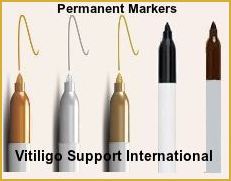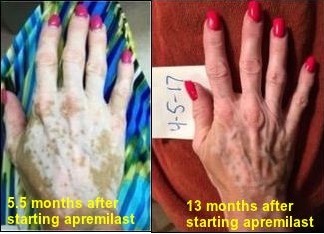| Click Here to View VSI Newsletter in Browser |
 |
||||||||||||||||||||||||||
This Newsletter Has Been Generously Sponsored By:
|
||||||||||||||||||||||||||
|
As I write this message, I’ve just returned from one of the most beautiful cities in the world, Paris, France. I had the honor of representing the USA on the steering committee for the first Vitiligo International Patient Organizations Conference (VIPOC). This was a landmark meeting attended by doctors, researchers, patient leaders, and industry representatives from 19 different countries.
One topic that sparked quite a bit of discussion was regarding patient treatment expectations. As a patient advocate who interacts with vitiligo patients from all over the world, I can tell you that there is indeed a gap between what doctors say and what patients hear. It is this very gap that leads to poor treatment compliance and outcome. This also is a subject of interest and concern of the pharmaceutical companies. Do patients want more treatments? Is it worth their investment to bring vitiligo drugs to market? Unfortunately, pharmaceutical companies primarily interact with the researchers and clinicians. The scientific and medical communities tend to look at numbers and percentages. My personal experience, as well as those of hundreds of patients with whom I’ve spoken or corresponded, began with a doctor explaining what treatments can’t do, the amount of pigment that probably can’t be regained, the percentages of relapse, the cost, and the time commitment. WOW! It’s no wonder so many patients give up on treatment before it has had a chance to work. I cannot overstate the importance of positive communication. Initially patients need emotional support. Drop the stats. They want to be treated with respect and understanding. Yes, vitiligo can be unpredictable, but it is treatable. Yes, it might take a while, but if given realistic expectations and a sense that their doctor cares about their success and is willing to stay with them for the journey, the chances are far greater that they will stick with a treatment to a far more favorable outcome. Each time I participate in multi-cultural discussions, I am reminded that no matter how far apart we are geographically, we have more in common than not. We may come to the table from different cultures and customs, but in the end, we all want the same things. We want validation that vitiligo is much more than a cosmetic disorder. We want access to treatments and more research. We want our voice to be heard and understood! This is exactly why your patient advocate needs a seat at the table.
Sincerely,
How Well do you Know VSI? What is Your Perception of VSI, and Many times when speaking with VSI members, we find they are surprised to learn about VSI’s history, programs, and resources. Some of our long-time members have questions about why changes were made, and some of our newer members are unaware of features and functions that at one time were synonymous with VSI’s identity.
VSI recently reached out to some of our members for some feedback. We asked them about the services and resources they found most valuable, as well as their thoughts and ideas of ways we might better serve their needs. We noticed a divide in the perception and expectations between those who joined in the early days of “Vitiligo Support” and those who’ve joined in recent years. We learned that some of the long-timers still tend to think of VSI primarily as a website with online forums, as opposed to a nonprofit organization, and their suggestions were primarily about chat rooms and forum functions. Interestingly, many of our newer members and donors were completely unaware of VSI’s forums, and instead found value in the resources such as our quarterly e-newsletters, work in advocacy and awareness, current treatment information, assistance with insurance coverage, and locating a doctor to prescribe a treatment. One consistent thought from both old and new...... Our work depends on the financial support of the community we serve, and we know that donors should have a clear idea of where their dollars are going and how they’re being used. We decided to take this opportunity to outline VSI’s history, explain decisions that resulted in change, and summarize the work we’re doing on behalf of the vitiligo community. VSI’s Roots January 17, 1994: The devastating 6.7 magnitude Northridge earthquake occurred in the San Fernando Valley region of California. The destruction was massive, taking many years for recovery. In the months that followed, one affected resident named Randy Salter developed vitiligo. Like so many others, he had never heard of vitiligo. The internet was in its infancy, and current and/or accurate information was very difficult to find. The doctors he initially saw told him that vitiligo was untreatable, and to be glad he didn’t have something serious like cancer. As his vitiligo spread, his frustration mounted.May 2000: Randy founded VitiligoSupport.com to fulfill the need for a central location where those affected by vitiligo could find legitimate information, but more importantly, to interact and share support in a safe environment away from online solicitors and scammers.
Membership steadily increased, soon positioning VSI
To better serve the growing international diversity, geographic and multi-cultural forums were created to address the more specific ethnic and cultural needs of VSI's worldwide community.
Do you know why the jigsaw puzzle was chosen as the logo? While working to solve the vitiligo puzzle, Growth and Change:
2003: 25,000 registered members As membership increased, similarities began to surface in the progression of patients’ emotions and concerns. Initially, the greatest need was for emotional support. But as spirits healed - and the acute emotional phase began to fade, patients began to develop an awareness of the “bigger picture.”
At this stage, frustration and resentment from the blatant disregard of their disease – the disparity of access to treatment, and the meager prospects of improvement, began to surface, leading to their quest for much more.
It soon became apparent that forums, chat rooms, and support groups certainly filled a need, and served an important purpose, but were not a sustainable solution. It was time to branch out from the narrow patient-to-patient focus - primarily serving the needs of today - to the more challenging and sustainable goal to fundamentally improve the future for those affected by vitiligo.
Transformation: May 2004: 27,000 members strong Vitiligo Support stepped up to the challenge and incorporated, officially becoming
Most nonprofits start at the ground level, building their membership along with their support and services.
No longer just a website or a support group, as a nonprofit organization, VSI’s services quickly became greater than forums, phone calls, and emails. The new designation came with the new responsibilities of increasing professional partnerships and modifying the organization’s infrastructure to facilitate the transition to a higher, national level of representation, with a greater emphasis on education, research and advocacy. 2007: Over 43,000 Worldwide Registered Members In little over three years, with membership steadily growing, the demands for assistance and support increased exponentially, far exceeding the organization’s capacity. VSI made the tough decision to initiate a paid membership level to financially support its expanding programs, services, and advocacy. Free online accounts remained available and still provided access to all of the forums. However, posting and/or replying in the forums became a benefit of the $25 Annual Supporting Membership. Many of the “long-timers” resented a fee to post and reply, and began to fall by the wayside.
2018: Over 60,000 Registered Members
VSI's ability to reach, connect with, and provide information to vitiligo patients all over the world, has led to its identity as a unique and valuable asset to the vitiligo community.
Representation and Collaboration VSI increased efforts toward rebranding its identity and services from those of an online community, to a nationally focused nonprofit organization; and to convey the importance of national representation to eliminate the barriers to vitiligo research, education and access to care, and ultimately, improve the future environment for the vitiligo community. Taking a frontline approach to crucial partnerships, collaboration with the world’s foremost leaders of the scientific, medical, and professional communities initiated the process that would establish VSI as a unique leader in the vitiligo world, with a more global focus.
Increasing Awareness Even though vitiligo is one of the
most prevalent autoimmune disorders,
Recognizing the need to evoke real and positive change meant increasing the visibility of vitiligo and advocating for increased research funding, VSI identified national advocacy as an important path of action. VSI meets with legislators on Capitol Hill several times a year, advocating for legislation to improve public health policy for those affected by vitiligo.
Also key to this process has been VSI’s effort to cultivate and maintain communication and personal relationships with the directors at the National Institutes of Health (NIH), who are responsible for funding vitiligo-related research.
Office Support VSI is the only vitiligo organization providing Receiving referrals from the NIH, Johns Hopkins, Mayo Clinic, American Academy of Dermatology, and many other professional organizations, VSI stays very busy on the home front responding to email and phone calls that come in 24/7. VSI’s extensive networking capabilities have led to the organization’s identity as a principle means of support, and a valuable asset, to the broader professional community.
Local dermatologists who treat vitiligo Hard-to-find prescriptions like monobenzone Specialists such as doctors and clinics performing surgical procedures VSI Also Provides Resources for: Researchers & Investigators: recruiting patients for clinical trials, surveys, and research studies, and providing letters of support for research funding Industry: seeking patient participation or feedback for new or improved products, and accurate information for updating their educational resources and websites Media: seeking current information for television, newspapers, educational publishers, and periodicals School Counselors and Social Workers: seeking support and resources for students and/or adult clients Professional organizations: requesting VSI's assistance contacting and educating patients on critical national campaigns And Above All, The Power of Knowledge!
VSI regularly receives emails and phone calls from emotionally distraught patients. Many have been told there are no treatments; the treatments are dangerous and don’t work; even if they regain pigment they’ll just lose it again; vitiligo is not dangerous and won’t hurt them; or to just cover it with make-up and learn to live with it. VSI listens; understands; cares; and conveys.... Take a Stand: Take Charge! Reaching out for information is the first step in facing your fears. You can either let vitiligo rule your life, or arm yourself with the knowledge necessary to put vitiligo where it belongs, and regain control of your life. VSI has become the driving force in patient education: answering the questions, dispelling myths, providing current and accurate information, and empowering patients with the courage to face tomorrow.Educational Resources VSI’s most comprehensive educational resource is its patient e-newsletter,
Dedicating hundreds of hours to each edition, VSI researches, writes, formats, and produces the only comprehensive, regularly circulated vitiligo patient newsletter. Each edition includes a featured article, treatment updates, medical news updates from around the world, answers to the most popular patient questions, and announcements of recruiting clinical trials.
Connecting Patients and Medical Experts VSI serves as a liaison, communicating the opinions
VSI was Honored to Represent the USA
VSI took the opportunity to collaborate with a broad spectrum of international vitiligo stakeholders. Gardner voiced the needs and concerns of vitiligo patients, and led a working group on the subject of patient empowerment.
Is the Future Important to You? Each day, one step at a time, VSI continues its work to make sure the voice of the patient is heard and understood, and to bridge the gap between the unmet needs of vitiligo patients, and those who can change and meet them. VSI firmly believes that the vitiligo community deserves the same strong patient advocacy representation as other higher profile skin diseases, like psoriasis. We are doing all that we can with the resources we have. If you believe that vitiligo is important and deserves stronger representation, please support VSI with your contribution toward a better future. It’s important for my children’s future to support an organization that is building awareness. If they ever develop vitiligo, I want VSI to be there for them, like it was for me. VSI Supporting Member A.R. “My donation is just a small contribution towards the good causes of VSI. The website maintained by VSI is very resourceful and I'm glad I can reach it over the internet. So long as the activities of VSI can be sustained, it can provide enormous support to the vitiligo community in the world.” VSI Supporting Member M.L. Please Support VSI in its Crusade VSI continues its commitment to providing
compassionate patient support, and a
One Voice – One Cause
Calling all Medicare Vitiligo Patients!
Part of the problem is that currently there is no accepted standard for coverage of vitiligo treatments. Each company has their own policies and guidelines, many times based on outdated and incorrect information. What most people may not realize is just how much private insurance coverage can be affected by Medicare policies. Over 55 million Americans are now covered by Medicare or Medicare Advantage, making it the nation’s largest health insurance program. Consequently, many, if not most, insurance providers establish their baseline standards and procedures to follow the Medicare model. We have been in touch with Medicare and have been told that if we can provide a Medicare letter of denial for a vitiligo treatment, then they will try to help us set a standard of coverage. If you are reading this newsletter and you, or someone you know, was denied coverage for a vitiligo treatment by Medicare, please contact VSI immediately. You could help make a difference for future insurance coverage for ALL vitiligo patients! Click Here to Contact VSI
What's On Your Mind? Q. What can I use to color my eyebrows that have turned white?
As always, you would want to do your homework to confirm the ingredients and take care to avoid those products that contain chemicals identified as problematic for vitiligo. Unfortunately, many of these products do not include an ingredient list in the store package, so you’ll likely need to look online before purchasing. In a previous newsletter, VSI asked Ray Boissy, Ph.D., Professor of Dermatology & Cell Biology and Director of Basic Science Research at the University of Cincinnati College of Medicine for a list of the hair dye ingredients known to cause pigment loss. We can only report on chemicals that have been tested for vitiligo, so while the chemicals listed below are known to cause pigment loss, there may be others as yet unidentified. Butylated Hydroxytoluene (BHT);
Highlights of recently-published medical Repigmentation of Tenacious Vitiligo on Apremilast In 2017, in Toledo Ohio, doctors Sara B. Huff and Lorie D. Gottwald released a case report of a 52-year-old woman with longstanding (23 years) vitiligo. She’d tried many prescribed treatments over the years with no response. In frustration, she’d stopped all treatments over the past 5 years. She and her doctors discussed the drug apremilast (brand name Otezla), prescribed for psoriasis and psoriatic arthritis. Because these two diseases share a common pathway of autoimmunity and inflammatory signals with vitiligo, the doctors felt the drug might also work for vitiligo. After only 6 weeks of apremilast treatment (30 mg twice daily), the patient reported new repigmentation. After 3 months of continued improvement, while maintaining the 30 mg apremilast twice daily, the doctors bolstered her treatment with a 60 mg intramuscular triamcinolone acetonide injection. The doctors noted that many years of steroids as a solo therapy had provided no benefit. Six weeks after the first injection, she began to notice repigmentation on her hands, but also noted some darkening in areas of normal skin. She received a second 60 mg intramuscular triamcinolone acetonide injection at this time and continued the apremilast.
Improvement continued, and at 6.5 months after beginning the apremilast therapy, she reported repigmentation on both arms, legs, hands, feet, chest and face. After 11 months on apremilast, and 5 months after the last steroid injection, she had achieved 60-70% repigmentation on her chest and arms, and was also repigmenting on her face. The doctors note the advantages of apremilast therapy include the ease of oral administration, mimimal drug interaction, and its safety profile. A Phase 2 Clinical Trial of apremilast and phototherapy with non-segmental vitiligo is underway in New York, though no longer recruiting. We will be following this study, and will report any results as they are published.
Improved Color Matched Repigmentation Using a One month prior to the grafting, the patient began phototherapy three times a week on the depigmented skin, using monochromatic excimer laser (MEL), with an exposure time of 2 minimal erythema doses (MEDs).
Seven days prior to the grafting, the patient received this same phototherapy treatment on the normal (pigmented) scalp area that was to be the donor site. Using the mMG machine, 250 punch biopsy pieces (1.0 mm in diameter, 1.8 mm deep) were taken from a small depigmented area above the jaw, and 250 pieces (1.0 mm in diameter, 1.5 mm deep) were taken from the donor site on the scalp. The donor biopsies were thinner so that they could be completely inserted into the holes where the biopsy pieces were removed in the depigmented area, using fine forceps, without the skin being raised. After one week, they began using the MEL phototherapy three times a week on the transplant areas. Repigmentation began within 2 or 3 weeks, and at one month was markedly increased. They initially noticed a slight cobble-stoning effect, but that soon resolved.
Four months later, this process was repeated on the next section of the jaw. Within 2 months, the grafts had survived, and repigmentation continued as in the first procedure. By this time (6 months after initial procedure), the first grafts showed excellent repigmentation, except for some hyperpigmentation (darker skin) around the borders. One month after the second mMG procedure, the process was again repeated on the center of the face (between the lips and nose). Though the repigmentation in the previously grafted areas was quite good, they noticed depigmented skin remained between the grafts at this point. Six months later, they performed the final grafting on these remaining areas, then for one month, in order to get a more uniform pigmentation, they exposed all grafts to narrow band UVB (NB-UVB) instead of MEL. They still noticed some hyperpigmentation at this stage; however, by 12 months after the first mMG procedure, the skin color had returned to normal.
The treatment has now been used successfully on over 100 patients with stable or progressive vitiligo. The researchers reported excellent color-matched repigmentation and note this to be an “easy and speedy” treatment of vitiligo. They noted that mini-punch grafting with NB-UVB has been used less successfully in the past. Though uncertain, they felt their success rate could be due in part to the differences in the phototherapy protocol. Previous efforts used only a suberythemal dose of NB-UVB, and only after the surgery.
New Paid Study in Encinitas CA!
Earn Funding for VSI with Amazon and eBay Online Shopping Can Benefit VSI!
Support VSI Through Ebay
|
|||||||||||||||||||||||||
| Copyright © 2018 Vitiligo Support International Inc. All rights reserved. Reproduction or republication strictly prohibited without prior written permission A Vitiligo Support International, Inc. financial statement is available upon written request from the Virginia Office of Consumer Affairs. Mail requests to: Virginia Department of Agriculture and Consumer Services, Office of Consumer Affairs, P.O. Box 1163, Richmond, Virginia 23218. Unsubscribe from the original email |
||||||||||||||||||||||||||


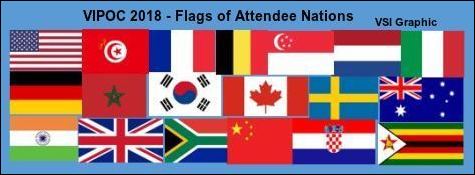

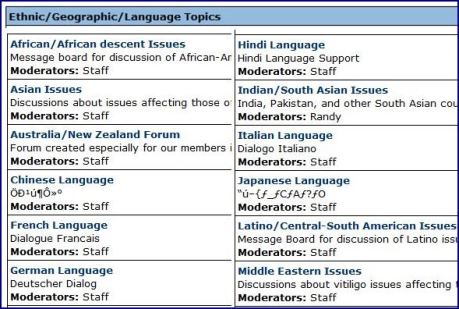
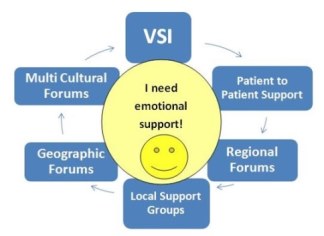
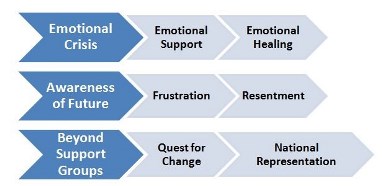

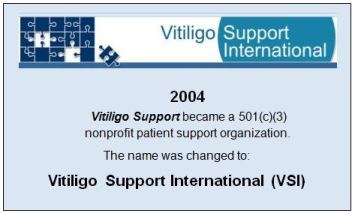
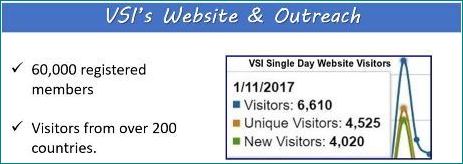

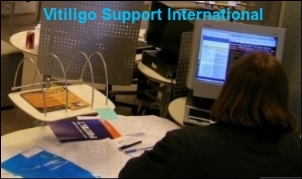 VSI Provides Patients and the Medical Community with:
VSI Provides Patients and the Medical Community with:

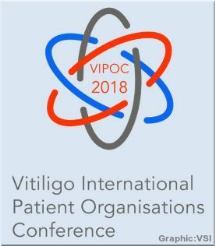
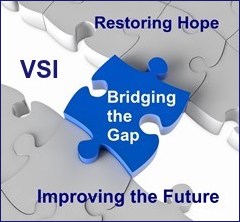


 VSI was unable to find any product testing specific to vitiligo for these types of cosmetics. However, some of our members have reported satisfactory results with various other eyebrow-oriented products, such as liquid eyeliner pens, as well as ordinary permanent markers.
VSI was unable to find any product testing specific to vitiligo for these types of cosmetics. However, some of our members have reported satisfactory results with various other eyebrow-oriented products, such as liquid eyeliner pens, as well as ordinary permanent markers. 